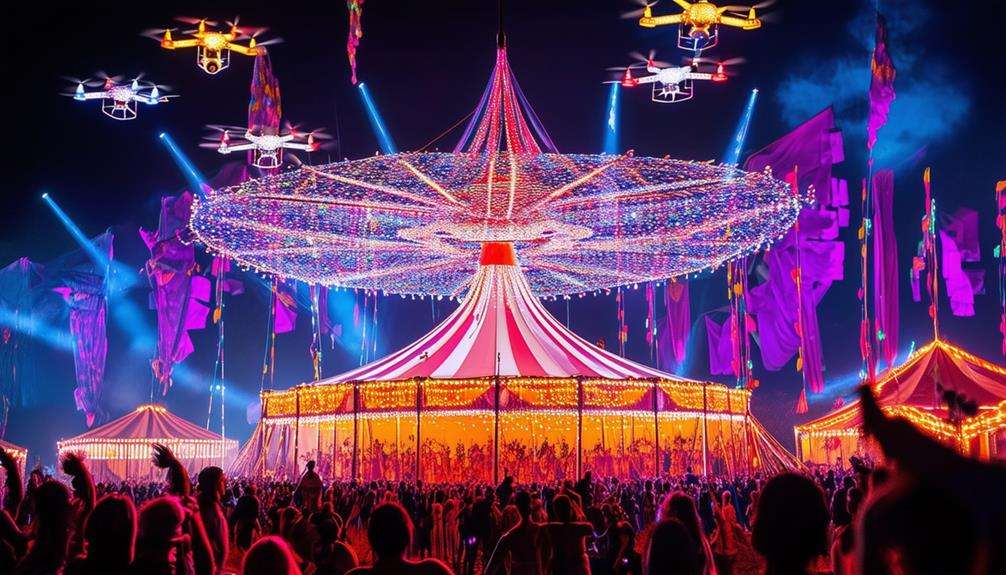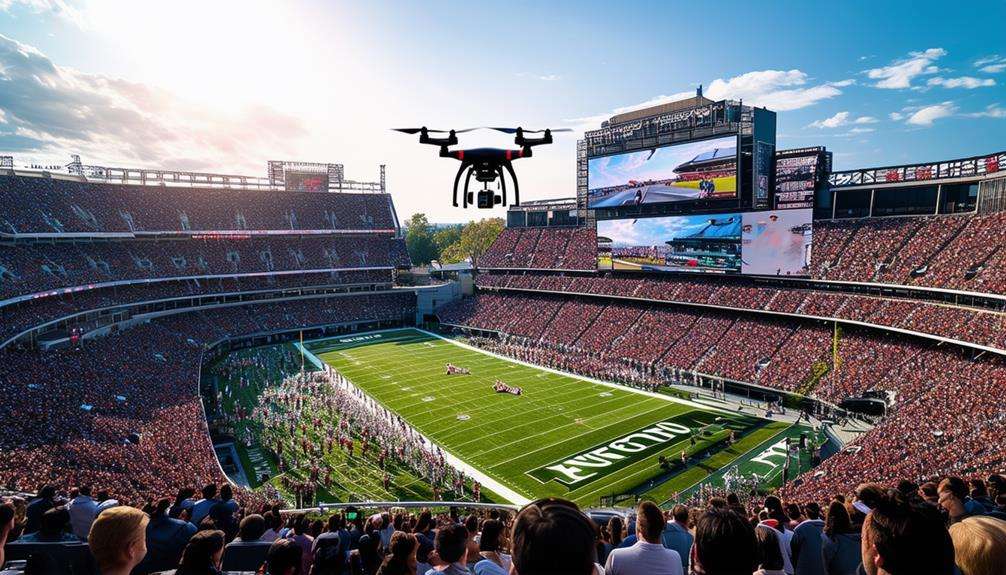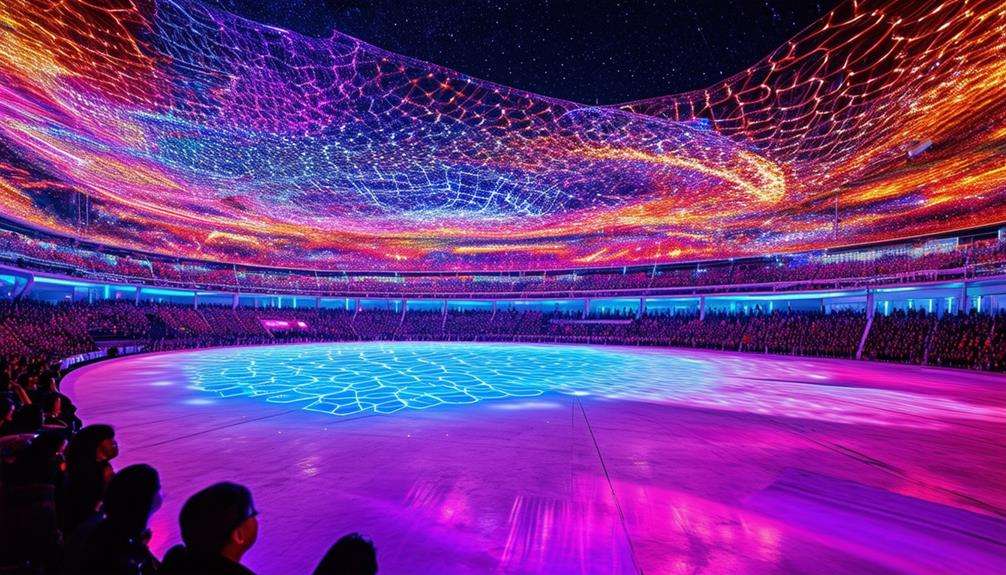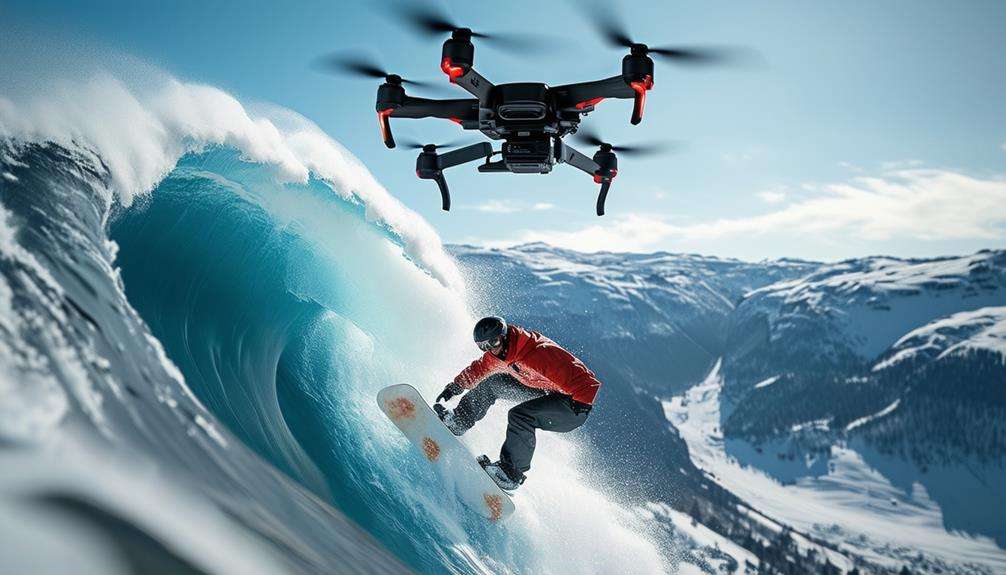Drones in Sports Broadcasting: Capturing the Action From Above
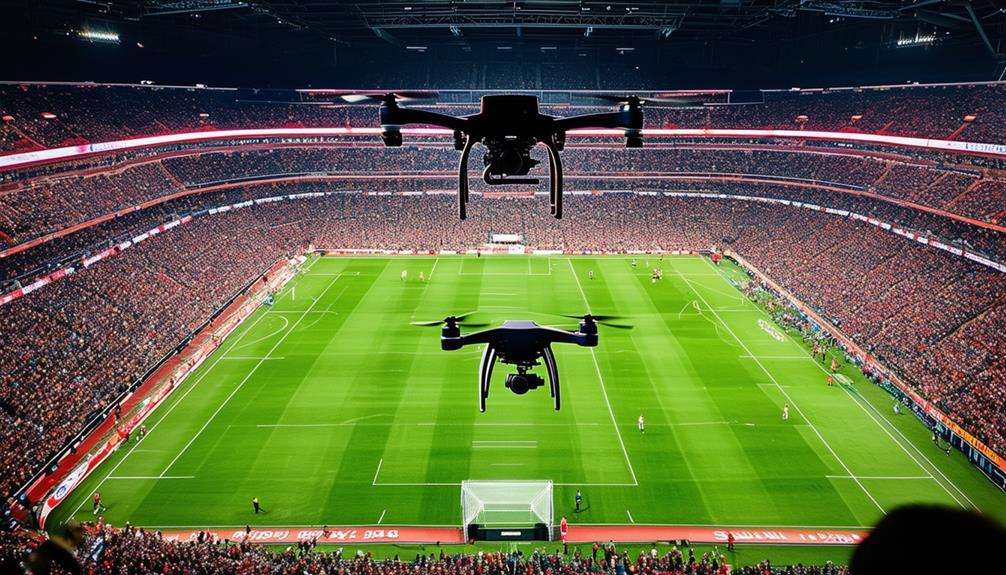
Imagine watching your favorite sports events from an entirely new perspective, courtesy of drones capturing the action from above. These high-tech devices provide unique aerial shots that traditional cameras simply can't match, offering a comprehensive view of the game and an enhanced appreciation of the athletes' skills from every angle.
Drones not only enrich your viewing experience but also offer cost-effective solutions and real-time streaming capabilities. But how do they manage to do all this while ensuring safety and regulatory compliance? Let's explore how drones are transforming the world of sports broadcasting.
Capturing Unique Perspectives
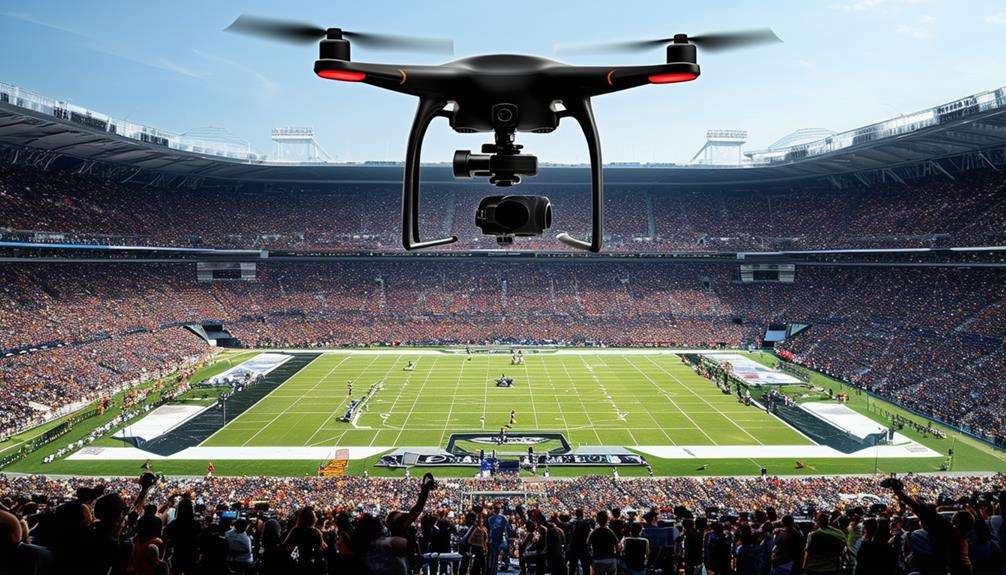
Drones offer unparalleled angles and aerial shots that capture dynamic action sequences with precision. When watching a football game or a golf tournament, drones provide breathtaking views that are otherwise unattainable. These unique perspectives enhance the ability to follow the game and fully appreciate the athletes' skills.
In sports broadcasting, capturing action from above isn't merely about aesthetics; it adds a new layer of understanding to the game. A bird's-eye view of the entire field reveals team strategies and player movements in ways ground-level cameras cannot. The visual appeal of these aerial shots is undeniable, making games more engaging for viewers.
Additionally, drones excel in covering expansive playing fields, offering detailed views of ongoing action. Whether it's a fast-paced football match or a tranquil golf course, drones enrich the viewing experience by providing dynamic shots.
These high-flying cameras have revolutionized sports broadcasting, transforming every game into a visually captivating spectacle. So, next time you're watching a game, appreciate the unique perspectives drones bring to the field.
Enhancing Live Broadcasts
Building on their ability to capture unique perspectives, high-flying cameras significantly enhance live sports broadcasts by providing real-time aerial footage. With drone technology, you get a bird's-eye view of the action, offering diverse angles that traditional cameras can't achieve. Imagine watching a football game and seeing the entire field from above; this vantage point helps you understand player formations and strategies much better. This aerial footage allows for extensive coverage of vast playing fields, from sprawling golf courses to expansive stadiums.
Drones don't just capture static views; they follow the dynamic action on the field. As a fan, you'll feel more immersed in the game when you see fast-paced sequences captured from above, providing a richer, more engaging viewing experience. These unique angles also highlight the athleticism and tactics involved, enhancing your appreciation of the sport.
Real-Time Streaming
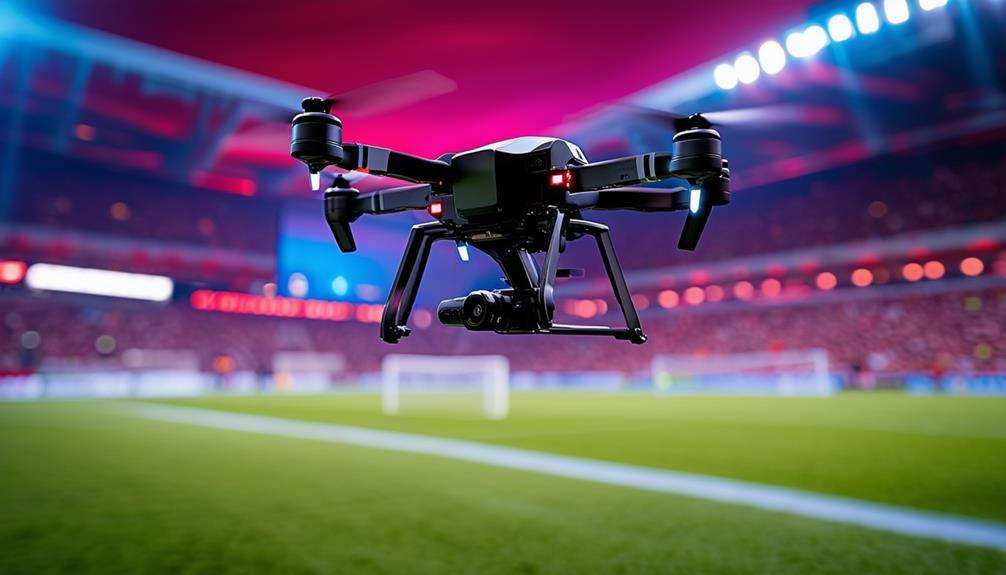
Picture watching your favorite game with a bird's-eye view that captures every play from an aerial perspective. Drones equipped with real-time streaming capabilities deliver this unique vantage point directly to your screen, offering dynamic angles that traditional cameras can't match.
With live feed technology, drones transmit stunning visuals instantly to the broadcast booth, ensuring you see the sporting action as it happens, without delays. The clarity provided by 4K drone footage immerses you in the game, making every pass, play, and goal more thrilling.
The aerial perspective offered by drones captures the entire field, providing a detailed view of the strategies and movements of every player. This comprehensive coverage enriches your understanding of the game and adds an extra layer of excitement.
The dynamic angles and stunning visuals make you feel like you're right there in the stadium, experiencing the energy and intensity firsthand. Real-time streaming through drones transforms your sports viewing experience, making it more immersive and exhilarating than ever before.
Boosting Fan Engagement
Real-time streaming isn't just about stunning visuals; it also plays a crucial role in enhancing fan engagement through interactive and immersive experiences. Drones offer unique aerial perspectives, capturing dynamic footage that viewers find captivating. Imagine watching your favorite sports event from angles previously unseen, creating a sense of being right in the middle of the action. This not only elevates the viewing experience but also keeps fans glued to their screens.
Incorporating drones into interactive games during events captivates fans, providing entertainment that surpasses traditional broadcasting. Activities like drone races during halftime or interactive drone challenges make the event more engaging and enjoyable. Spectacular drone shows that light up the sky with coordinated movements and vibrant displays add another layer of excitement, turning a regular game night into a memorable experience.
Drones can even deliver game balls and presents, surprising fans and adding elements of delight and wonder. Including drone coverage in broadcasts enhances viewer engagement by offering previously unseen angles and perspectives, making every moment more exciting and keeping fans coming back for more.
Cost-Effective Solutions
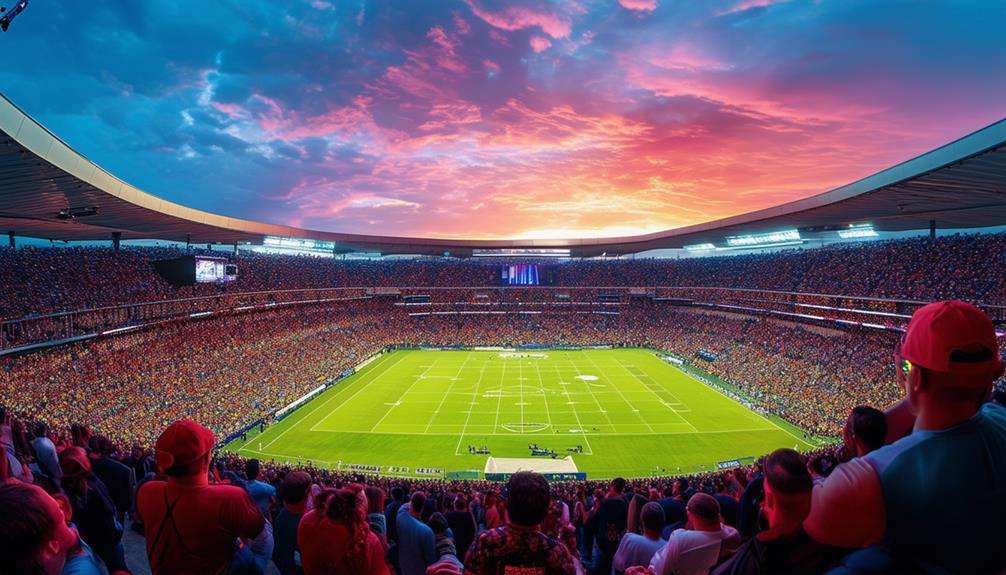
Drones offer a cost-effective solution for sports broadcasting, providing high-quality aerial coverage without the high costs of traditional methods like helicopters or cranes. This technology significantly reduces operational expenses, making it easier to manage your budget while delivering stunning visuals. Both major and smaller sports events can benefit from drones, capturing high-quality footage without overspending.
By choosing drones for sports broadcasting, you opt for an essential and accessible technology that maintains high-quality standards. The visuals captured by drones ensure every thrilling moment is recorded from unique angles, enhancing the viewer experience. Reduced operational costs allow you to allocate resources to other critical areas, improving overall production value.
Safety and Accessibility
Using drones in sports broadcasting ensures regulatory compliance, enhancing safety for all participants. These drones minimize risks and engage the audience by providing unique perspectives and shots previously unattainable. With careful planning and weather monitoring, drones can revolutionize the live sports experience.
Regulatory Compliance Measures
Ensuring the safe and legal operation of drones in sports broadcasting requires strict adherence to regulatory compliance measures. Compliance with safety guidelines and aviation regulations is essential to guarantee smooth and secure drone operations during sports events. Since each country and event may have distinct rules, drone operators must be well-versed in these regulations to maintain compliance.
Compared to traditional methods like helicopters and cranes, operating drones in sports broadcasting offers significant advantages. Drones minimize physical risks, thereby reducing the likelihood of accidents and injuries. This makes them an appealing option for capturing aerial footage while ensuring the safety of both operators and the audience.
Drones also provide unparalleled accessibility, reaching hard-to-access areas and tight spaces effortlessly. This capability not only enhances the quality of the broadcast but also ensures that all operations are conducted within regulatory confines.
Adhering to these rules isn't just a legal obligation but a critical aspect of maintaining high safety standards. By prioritizing regulatory compliance, drones can be used to enhance sports broadcasting in a safe, efficient, and legally compliant manner.
Audience Engagement Benefits
Drones offer a transformative enhancement to sports broadcasting by providing unique aerial views that captivate audiences and enrich the overall experience. These sweeping shots from above offer a comprehensive perspective of the field, strategic plays, and crowd energy, making the viewing experience more immersive.
Safety is another significant advantage. Unlike helicopters, drones are safer to operate, reducing risks in crowded stadiums and eliminating the need for large, noisy machinery. Remote operation minimizes accidents and injuries, ensuring the safety of athletes and fans alike.
Drones also enhance accessibility by reaching areas in a stadium that traditional cameras cannot. This capability ensures comprehensive coverage from every angle, thereby improving the broadcast quality.
Regulations and Compliance
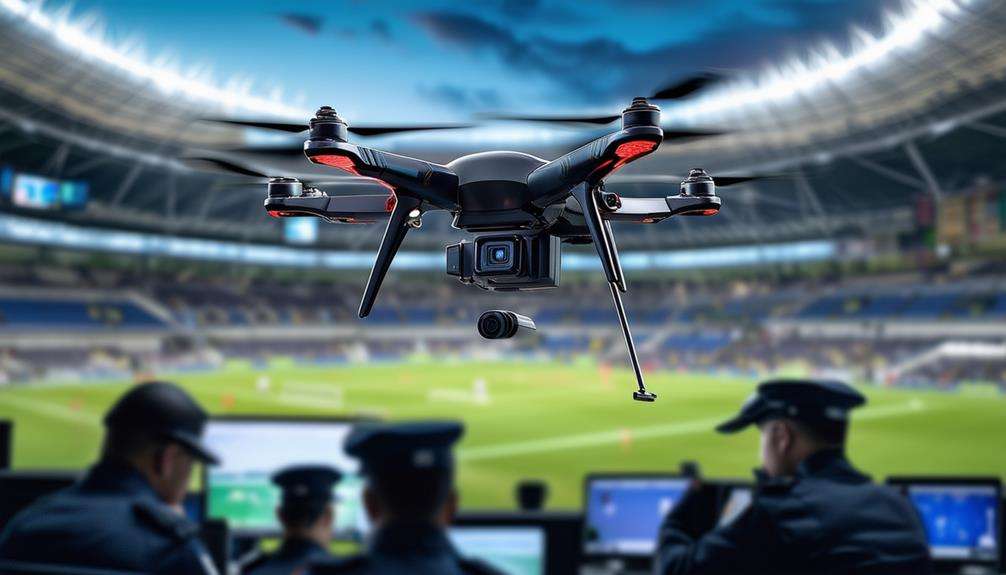
Understanding the intricate network of regulations and compliance is vital for drone operators in sports broadcasting to guarantee safe and legal operations. Adhering to strict safety guidelines and aviation regulations is essential when filming sports events.
Compliance with country-specific drone regulations ensures that operators are within the law and maintaining safety standards. As regulations governing drone use in sports broadcasting can vary widely, staying informed and updated is crucial.
Adherence to these regulations isn't just about legality; it ensures the safety of athletes, spectators, and the general public. Operators need to understand and follow drone flight restrictions and no-fly zones to avoid potential hazards. For instance, flying a drone too close to a crowded stadium or within restricted airspace can result in severe legal consequences and safety risks.
Privacy concerns and potential game interference also necessitate careful planning. Drone operations must be meticulously planned to respect privacy laws and minimize any disruption to the event.
Challenges and Limitations
Using drones in sports broadcasting involves navigating regulatory hurdles to ensure safety in crowded stadiums. Additionally, managing battery life is crucial, as limited power can disrupt coverage if not planned strategically. Effective operation requires technical skill and meticulous preparation to address these challenges.
Regulatory Hurdles and Compliance
Navigating the complex regulatory landscape is crucial for drone operators in sports broadcasting to ensure safety and compliance. The stringent FAA regulations dictate how and where drones can be flown, and adherence to these rules is essential to avoid fines and operational disruptions.
One significant challenge is obtaining the necessary licenses, permits, and authorizations. Different sports events may have specific regulations, including no-fly zones and airspace restrictions, designed to safeguard participants and spectators.
Privacy concerns also pose a substantial challenge. Establishing protocols to protect individuals' privacy is essential, as unauthorized recordings can result in legal consequences. Moreover, implementing robust safety protocols is paramount to ensure that drone operations don't endanger people or property.
Understanding and complying with these regulations isn't merely a formality; it ensures that drone activities are safe, legal, and respectful of privacy. Mastering this regulatory landscape is essential for the successful integration of drones in sports broadcasting.
Battery Life Constraints
Drone operators often face battery life limitations that restrict continuous filming to 20-30 minutes per charge. This is particularly challenging during sports events where uninterrupted coverage is crucial. To address these constraints, strategic battery management and frequent battery swaps are necessary to ensure seamless filming.
Despite advancements in battery technology, many drones still require careful monitoring to avoid mid-air shutdowns. While some high-end models offer flight durations of up to 40-50 minutes, they aren't yet the standard.
Effective management of these limitations is essential:
- Monitor Battery Levels: Regularly check battery status to ensure safe return-to-home functionality and prevent unexpected shutdowns.
- Plan Battery Swaps: Have multiple charged batteries ready and schedule swaps during less critical moments to minimize disruptions.
- Utilize Advanced Drones: If budget permits, invest in drones with longer flight durations to reduce the need for frequent battery changes.
Future Trends and Innovations
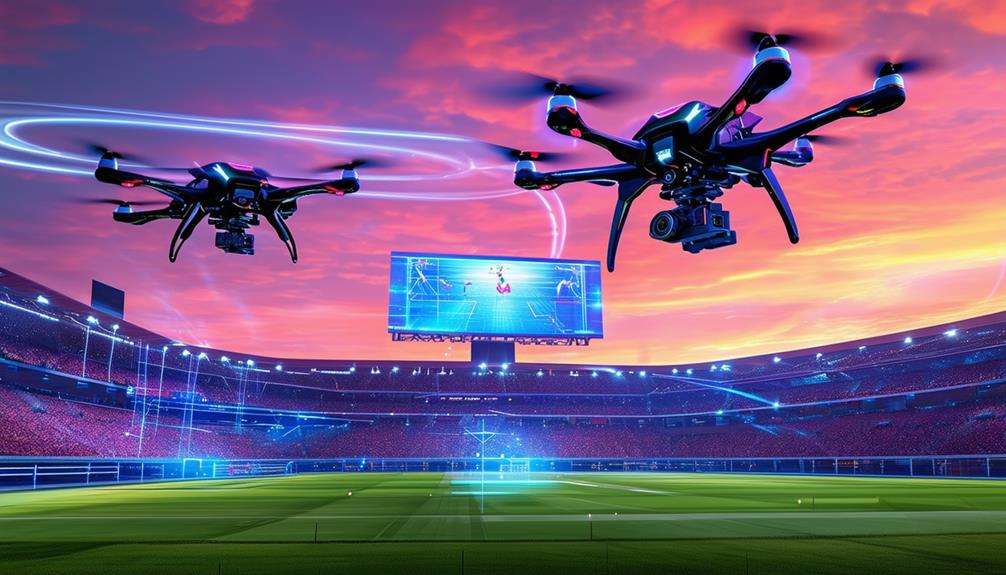
Embracing advanced drone technology, future trends in sports broadcasting are set to offer unparalleled live coverage and dynamic perspectives. Innovations in drone technology are facilitating real-time streaming of 4K footage, delivering exceptional clarity. This ensures viewers can capture every detail, creating an immersive experience that feels like being at the event.
Drones provide unique storytelling angles that traditional cameras can't achieve. Imagine viewing a football game from above, capturing the entire field and player movements in a single shot. This dynamic perspective not only attracts a larger audience but also significantly enhances viewer engagement.
The excitement drones bring to sports broadcasting is transformative. They establish new standards in coverage by capturing comprehensive angles at large-scale events, from marathons to motorsports. This immersive viewing experience keeps audiences on the edge of their seats, deepening their connection to the event.
As drone technology continues to advance, expect features like AI-driven flight paths and automated highlight reels. These innovations will further revolutionize sports broadcasting, ensuring viewers receive the most thrilling, detailed, and engaging coverage possible. The future of sports broadcasting is airborne and more exciting than ever.
Conclusion
Drones have revolutionized sports broadcasting by providing unique aerial perspectives, enhancing live broadcasts, and boosting fan engagement. They offer cost-effective solutions while ensuring safety and accessibility. Despite regulatory challenges, the advantages are undeniable. As technology advances, expect even more innovative uses of drones in sports coverage. Get ready to experience the thrill of the game from breathtaking aerial angles like never before!

